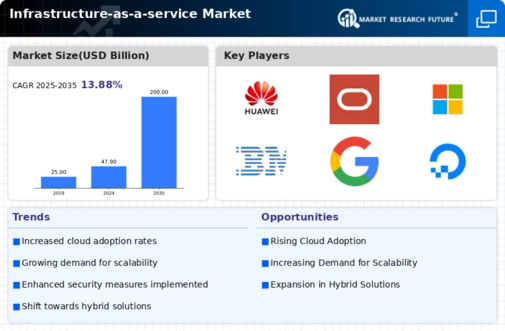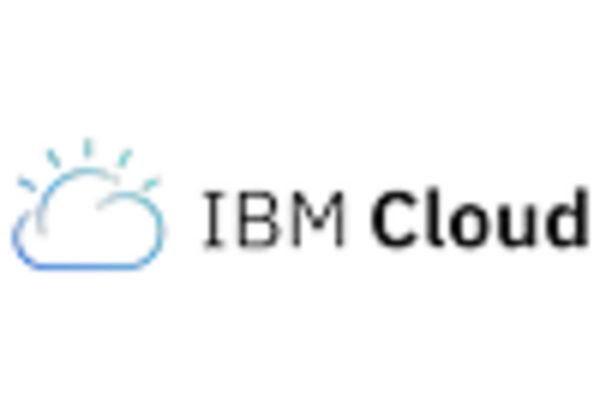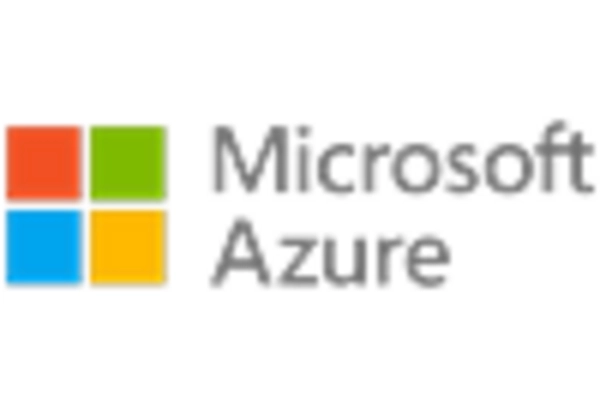-
FACTOR ANALYSIS
-
Value chain Analysis
-
Porter's
-
Five Forces Analysis
-
Bargaining Power of Suppliers
-
Bargaining
-
Power of Buyers
-
Threat of New Entrants
-
Threat
-
of Substitutes
-
Intensity of Rivalry
-
COVID-19
-
Impact Analysis
-
Market Impact Analysis
-
Regional
-
Impact
-
Opportunity and Threat Analysis
-
Infrastructure
-
as a Service Market, BY Deployment Model (USD Billion)
-
Public
-
Cloud
-
Private Cloud
-
Hybrid
-
Cloud
-
Infrastructure as a Service
-
Market, BY Service Type (USD Billion)
-
Compute
-
Storage
-
Networking
-
Disaster
-
Recovery
-
Infrastructure as
-
a Service Market, BY End User (USD Billion)
-
IT
-
and Telecommunications
-
BFSI
-
Healthcare
-
Retail
-
Government
-
Infrastructure
-
as a Service Market, BY Application (USD Billion)
-
Business
-
Continuity
-
Data Backup
-
Test
-
and Development
-
Big Data Analytics
-
Infrastructure
-
as a Service Market, BY Regional (USD Billion)
-
North
-
America
-
US
-
Canada
-
Europe
-
Germany
-
UK
-
France
-
Russia
-
Italy
-
Spain
-
Rest
-
of Europe
-
APAC
-
China
-
India
-
Japan
-
South
-
Korea
-
Malaysia
-
Thailand
-
Indonesia
-
Rest
-
of APAC
-
South America
-
Brazil
-
Mexico
-
Argentina
-
Rest
-
of South America
-
MEA
-
GCC
-
Countries
-
South Africa
-
Rest
-
of MEA
-
Competitive
-
Landscape
-
Overview
-
Competitive
-
Analysis
-
Market share Analysis
-
Major
-
Growth Strategy in the Infrastructure as a Service Market
-
Competitive
-
Benchmarking
-
Leading Players in Terms of Number of Developments
-
in the Infrastructure as a Service Market
-
Key developments
-
and growth strategies
-
New Product Launch/Service Deployment
-
Merger
-
& Acquisitions
-
Joint Ventures
-
Major
-
Players Financial Matrix
-
Sales and Operating Income
-
Major
-
Players R&D Expenditure. 2023
-
Company
-
Profiles
-
Alibaba Cloud
-
Financial
-
Overview
-
Products Offered
-
Key
-
Developments
-
SWOT Analysis
-
Key
-
Strategies
-
IBM
-
Financial
-
Overview
-
Products Offered
-
Key
-
Developments
-
SWOT Analysis
-
Key
-
Strategies
-
SAP
-
Financial
-
Overview
-
Products Offered
-
Key
-
Developments
-
SWOT Analysis
-
Key
-
Strategies
-
Rackspace
-
Financial
-
Overview
-
Products Offered
-
Key
-
Developments
-
SWOT Analysis
-
Key
-
Strategies
-
Salesforce
-
Financial
-
Overview
-
Products Offered
-
Key
-
Developments
-
SWOT Analysis
-
Key
-
Strategies
-
Google
-
Financial
-
Overview
-
Products Offered
-
Key
-
Developments
-
SWOT Analysis
-
Key
-
Strategies
-
Amazon Web Services
-
Financial
-
Overview
-
Products Offered
-
Key
-
Developments
-
SWOT Analysis
-
Key
-
Strategies
-
DigitalOcean
-
Financial
-
Overview
-
Products Offered
-
Key
-
Developments
-
SWOT Analysis
-
Key
-
Strategies
-
Microsoft
-
Financial
-
Overview
-
Products Offered
-
Key
-
Developments
-
SWOT Analysis
-
Key
-
Strategies
-
Tencent Cloud
-
Financial
-
Overview
-
Products Offered
-
Key
-
Developments
-
SWOT Analysis
-
Key
-
Strategies
-
Hewlett Packard Enterprise
-
Financial
-
Overview
-
Products Offered
-
Key
-
Developments
-
SWOT Analysis
-
Key
-
Strategies
-
VMware
-
Financial
-
Overview
-
Products Offered
-
Key
-
Developments
-
SWOT Analysis
-
Key
-
Strategies
-
Linode
-
Financial
-
Overview
-
Products Offered
-
Key
-
Developments
-
SWOT Analysis
-
Key
-
Strategies
-
Cisco
-
Financial
-
Overview
-
Products Offered
-
Key
-
Developments
-
SWOT Analysis
-
Key
-
Strategies
-
Oracle
-
Financial
-
Overview
-
Products Offered
-
Key
-
Developments
-
SWOT Analysis
-
Key
-
Strategies
-
Appendix
-
References
-
Related
-
Reports
-
LIST Of tables
-
LIST
-
OF ASSUMPTIONS
-
North America Infrastructure as a Service
-
Market SIZE ESTIMATES & FORECAST, BY DEPLOYMENT MODEL, 2019-2035 (USD Billions)
-
North
-
America Infrastructure as a Service Market SIZE ESTIMATES & FORECAST, BY SERVICE
-
TYPE, 2019-2035 (USD Billions)
-
North America Infrastructure
-
as a Service Market SIZE ESTIMATES & FORECAST, BY END USER, 2019-2035 (USD Billions)
-
North
-
America Infrastructure as a Service Market SIZE ESTIMATES & FORECAST, BY APPLICATION,
-
North America Infrastructure
-
as a Service Market SIZE ESTIMATES & FORECAST, BY REGIONAL, 2019-2035 (USD Billions)
-
US
-
Infrastructure as a Service Market SIZE ESTIMATES & FORECAST, BY DEPLOYMENT
-
MODEL, 2019-2035 (USD Billions)
-
US Infrastructure as
-
a Service Market SIZE ESTIMATES & FORECAST, BY SERVICE TYPE, 2019-2035 (USD
-
Billions)
-
US Infrastructure as a Service Market SIZE
-
ESTIMATES & FORECAST, BY END USER, 2019-2035 (USD Billions)
-
US
-
Infrastructure as a Service Market SIZE ESTIMATES & FORECAST, BY APPLICATION,
-
US Infrastructure as a Service
-
Market SIZE ESTIMATES & FORECAST, BY REGIONAL, 2019-2035 (USD Billions)
-
Canada
-
Infrastructure as a Service Market SIZE ESTIMATES & FORECAST, BY DEPLOYMENT
-
MODEL, 2019-2035 (USD Billions)
-
Canada Infrastructure
-
as a Service Market SIZE ESTIMATES & FORECAST, BY SERVICE TYPE, 2019-2035 (USD
-
Billions)
-
Canada Infrastructure as a Service Market SIZE
-
ESTIMATES & FORECAST, BY END USER, 2019-2035 (USD Billions)
-
Canada
-
Infrastructure as a Service Market SIZE ESTIMATES & FORECAST, BY APPLICATION,
-
Canada Infrastructure as a Service
-
Market SIZE ESTIMATES & FORECAST, BY REGIONAL, 2019-2035 (USD Billions)
-
Europe
-
Infrastructure as a Service Market SIZE ESTIMATES & FORECAST, BY DEPLOYMENT
-
MODEL, 2019-2035 (USD Billions)
-
Europe Infrastructure
-
as a Service Market SIZE ESTIMATES & FORECAST, BY SERVICE TYPE, 2019-2035 (USD
-
Billions)
-
Europe Infrastructure as a Service Market SIZE
-
ESTIMATES & FORECAST, BY END USER, 2019-2035 (USD Billions)
-
Europe
-
Infrastructure as a Service Market SIZE ESTIMATES & FORECAST, BY APPLICATION,
-
Europe Infrastructure as a Service
-
Market SIZE ESTIMATES & FORECAST, BY REGIONAL, 2019-2035 (USD Billions)
-
Germany
-
Infrastructure as a Service Market SIZE ESTIMATES & FORECAST, BY DEPLOYMENT
-
MODEL, 2019-2035 (USD Billions)
-
Germany Infrastructure
-
as a Service Market SIZE ESTIMATES & FORECAST, BY SERVICE TYPE, 2019-2035 (USD
-
Billions)
-
Germany Infrastructure as a Service Market
-
SIZE ESTIMATES & FORECAST, BY END USER, 2019-2035 (USD Billions)
-
Germany
-
Infrastructure as a Service Market SIZE ESTIMATES & FORECAST, BY APPLICATION,
-
Germany Infrastructure as a
-
Service Market SIZE ESTIMATES & FORECAST, BY REGIONAL, 2019-2035 (USD Billions)
-
UK
-
Infrastructure as a Service Market SIZE ESTIMATES & FORECAST, BY DEPLOYMENT
-
MODEL, 2019-2035 (USD Billions)
-
UK Infrastructure as
-
a Service Market SIZE ESTIMATES & FORECAST, BY SERVICE TYPE, 2019-2035 (USD
-
Billions)
-
UK Infrastructure as a Service Market SIZE
-
ESTIMATES & FORECAST, BY END USER, 2019-2035 (USD Billions)
-
UK
-
Infrastructure as a Service Market SIZE ESTIMATES & FORECAST, BY APPLICATION,
-
UK Infrastructure as a Service
-
Market SIZE ESTIMATES & FORECAST, BY REGIONAL, 2019-2035 (USD Billions)
-
France
-
Infrastructure as a Service Market SIZE ESTIMATES & FORECAST, BY DEPLOYMENT
-
MODEL, 2019-2035 (USD Billions)
-
France Infrastructure
-
as a Service Market SIZE ESTIMATES & FORECAST, BY SERVICE TYPE, 2019-2035 (USD
-
Billions)
-
France Infrastructure as a Service Market SIZE
-
ESTIMATES & FORECAST, BY END USER, 2019-2035 (USD Billions)
-
France
-
Infrastructure as a Service Market SIZE ESTIMATES & FORECAST, BY APPLICATION,
-
France Infrastructure as a Service
-
Market SIZE ESTIMATES & FORECAST, BY REGIONAL, 2019-2035 (USD Billions)
-
Russia
-
Infrastructure as a Service Market SIZE ESTIMATES & FORECAST, BY DEPLOYMENT
-
MODEL, 2019-2035 (USD Billions)
-
Russia Infrastructure
-
as a Service Market SIZE ESTIMATES & FORECAST, BY SERVICE TYPE, 2019-2035 (USD
-
Billions)
-
Russia Infrastructure as a Service Market SIZE
-
ESTIMATES & FORECAST, BY END USER, 2019-2035 (USD Billions)
-
Russia
-
Infrastructure as a Service Market SIZE ESTIMATES & FORECAST, BY APPLICATION,
-
Russia Infrastructure as a Service
-
Market SIZE ESTIMATES & FORECAST, BY REGIONAL, 2019-2035 (USD Billions)
-
Italy
-
Infrastructure as a Service Market SIZE ESTIMATES & FORECAST, BY DEPLOYMENT
-
MODEL, 2019-2035 (USD Billions)
-
Italy Infrastructure
-
as a Service Market SIZE ESTIMATES & FORECAST, BY SERVICE TYPE, 2019-2035 (USD
-
Billions)
-
Italy Infrastructure as a Service Market SIZE
-
ESTIMATES & FORECAST, BY END USER, 2019-2035 (USD Billions)
-
Italy
-
Infrastructure as a Service Market SIZE ESTIMATES & FORECAST, BY APPLICATION,
-
Italy Infrastructure as a Service
-
Market SIZE ESTIMATES & FORECAST, BY REGIONAL, 2019-2035 (USD Billions)
-
Spain
-
Infrastructure as a Service Market SIZE ESTIMATES & FORECAST, BY DEPLOYMENT
-
MODEL, 2019-2035 (USD Billions)
-
Spain Infrastructure
-
as a Service Market SIZE ESTIMATES & FORECAST, BY SERVICE TYPE, 2019-2035 (USD
-
Billions)
-
Spain Infrastructure as a Service Market SIZE
-
ESTIMATES & FORECAST, BY END USER, 2019-2035 (USD Billions)
-
Spain
-
Infrastructure as a Service Market SIZE ESTIMATES & FORECAST, BY APPLICATION,
-
Spain Infrastructure as a Service
-
Market SIZE ESTIMATES & FORECAST, BY REGIONAL, 2019-2035 (USD Billions)
-
Rest
-
of Europe Infrastructure as a Service Market SIZE ESTIMATES & FORECAST, BY DEPLOYMENT
-
MODEL, 2019-2035 (USD Billions)
-
Rest of Europe Infrastructure
-
as a Service Market SIZE ESTIMATES & FORECAST, BY SERVICE TYPE, 2019-2035 (USD
-
Billions)
-
Rest of Europe Infrastructure as a Service
-
Market SIZE ESTIMATES & FORECAST, BY END USER, 2019-2035 (USD Billions)
-
Rest
-
of Europe Infrastructure as a Service Market SIZE ESTIMATES & FORECAST, BY APPLICATION,
-
Rest of Europe Infrastructure
-
as a Service Market SIZE ESTIMATES & FORECAST, BY REGIONAL, 2019-2035 (USD Billions)
-
APAC
-
Infrastructure as a Service Market SIZE ESTIMATES & FORECAST, BY DEPLOYMENT
-
MODEL, 2019-2035 (USD Billions)
-
APAC Infrastructure as
-
a Service Market SIZE ESTIMATES & FORECAST, BY SERVICE TYPE, 2019-2035 (USD
-
Billions)
-
APAC Infrastructure as a Service Market SIZE
-
ESTIMATES & FORECAST, BY END USER, 2019-2035 (USD Billions)
-
APAC
-
Infrastructure as a Service Market SIZE ESTIMATES & FORECAST, BY APPLICATION,
-
APAC Infrastructure as a Service
-
Market SIZE ESTIMATES & FORECAST, BY REGIONAL, 2019-2035 (USD Billions)
-
China
-
Infrastructure as a Service Market SIZE ESTIMATES & FORECAST, BY DEPLOYMENT
-
MODEL, 2019-2035 (USD Billions)
-
China Infrastructure
-
as a Service Market SIZE ESTIMATES & FORECAST, BY SERVICE TYPE, 2019-2035 (USD
-
Billions)
-
China Infrastructure as a Service Market SIZE
-
ESTIMATES & FORECAST, BY END USER, 2019-2035 (USD Billions)
-
China
-
Infrastructure as a Service Market SIZE ESTIMATES & FORECAST, BY APPLICATION,
-
China Infrastructure as a Service
-
Market SIZE ESTIMATES & FORECAST, BY REGIONAL, 2019-2035 (USD Billions)
-
India
-
Infrastructure as a Service Market SIZE ESTIMATES & FORECAST, BY DEPLOYMENT
-
MODEL, 2019-2035 (USD Billions)
-
India Infrastructure
-
as a Service Market SIZE ESTIMATES & FORECAST, BY SERVICE TYPE, 2019-2035 (USD
-
Billions)
-
India Infrastructure as a Service Market SIZE
-
ESTIMATES & FORECAST, BY END USER, 2019-2035 (USD Billions)
-
India
-
Infrastructure as a Service Market SIZE ESTIMATES & FORECAST, BY APPLICATION,
-
India Infrastructure as a Service
-
Market SIZE ESTIMATES & FORECAST, BY REGIONAL, 2019-2035 (USD Billions)
-
Japan
-
Infrastructure as a Service Market SIZE ESTIMATES & FORECAST, BY DEPLOYMENT
-
MODEL, 2019-2035 (USD Billions)
-
Japan Infrastructure
-
as a Service Market SIZE ESTIMATES & FORECAST, BY SERVICE TYPE, 2019-2035 (USD
-
Billions)
-
Japan Infrastructure as a Service Market SIZE
-
ESTIMATES & FORECAST, BY END USER, 2019-2035 (USD Billions)
-
Japan
-
Infrastructure as a Service Market SIZE ESTIMATES & FORECAST, BY APPLICATION,
-
Japan Infrastructure as a Service
-
Market SIZE ESTIMATES & FORECAST, BY REGIONAL, 2019-2035 (USD Billions)
-
South
-
Korea Infrastructure as a Service Market SIZE ESTIMATES & FORECAST, BY DEPLOYMENT
-
MODEL, 2019-2035 (USD Billions)
-
South Korea Infrastructure
-
as a Service Market SIZE ESTIMATES & FORECAST, BY SERVICE TYPE, 2019-2035 (USD
-
Billions)
-
South Korea Infrastructure as a Service Market
-
SIZE ESTIMATES & FORECAST, BY END USER, 2019-2035 (USD Billions)
-
South
-
Korea Infrastructure as a Service Market SIZE ESTIMATES & FORECAST, BY APPLICATION,
-
South Korea Infrastructure as
-
a Service Market SIZE ESTIMATES & FORECAST, BY REGIONAL, 2019-2035 (USD Billions)
-
Malaysia
-
Infrastructure as a Service Market SIZE ESTIMATES & FORECAST, BY DEPLOYMENT
-
MODEL, 2019-2035 (USD Billions)
-
Malaysia Infrastructure
-
as a Service Market SIZE ESTIMATES & FORECAST, BY SERVICE TYPE, 2019-2035 (USD
-
Billions)
-
Malaysia Infrastructure as a Service Market
-
SIZE ESTIMATES & FORECAST, BY END USER, 2019-2035 (USD Billions)
-
Malaysia
-
Infrastructure as a Service Market SIZE ESTIMATES & FORECAST, BY APPLICATION,
-
Malaysia Infrastructure as a
-
Service Market SIZE ESTIMATES & FORECAST, BY REGIONAL, 2019-2035 (USD Billions)
-
Thailand
-
Infrastructure as a Service Market SIZE ESTIMATES & FORECAST, BY DEPLOYMENT
-
MODEL, 2019-2035 (USD Billions)
-
Thailand Infrastructure
-
as a Service Market SIZE ESTIMATES & FORECAST, BY SERVICE TYPE, 2019-2035 (USD
-
Billions)
-
Thailand Infrastructure as a Service Market
-
SIZE ESTIMATES & FORECAST, BY END USER, 2019-2035 (USD Billions)
-
Thailand
-
Infrastructure as a Service Market SIZE ESTIMATES & FORECAST, BY APPLICATION,
-
Thailand Infrastructure as a
-
Service Market SIZE ESTIMATES & FORECAST, BY REGIONAL, 2019-2035 (USD Billions)
-
Indonesia
-
Infrastructure as a Service Market SIZE ESTIMATES & FORECAST, BY DEPLOYMENT
-
MODEL, 2019-2035 (USD Billions)
-
Indonesia Infrastructure
-
as a Service Market SIZE ESTIMATES & FORECAST, BY SERVICE TYPE, 2019-2035 (USD
-
Billions)
-
Indonesia Infrastructure as a Service Market
-
SIZE ESTIMATES & FORECAST, BY END USER, 2019-2035 (USD Billions)
-
Indonesia
-
Infrastructure as a Service Market SIZE ESTIMATES & FORECAST, BY APPLICATION,
-
Indonesia Infrastructure as
-
a Service Market SIZE ESTIMATES & FORECAST, BY REGIONAL, 2019-2035 (USD Billions)
-
Rest
-
of APAC Infrastructure as a Service Market SIZE ESTIMATES & FORECAST, BY DEPLOYMENT
-
MODEL, 2019-2035 (USD Billions)
-
Rest of APAC Infrastructure
-
as a Service Market SIZE ESTIMATES & FORECAST, BY SERVICE TYPE, 2019-2035 (USD
-
Billions)
-
Rest of APAC Infrastructure as a Service Market
-
SIZE ESTIMATES & FORECAST, BY END USER, 2019-2035 (USD Billions)
-
Rest
-
of APAC Infrastructure as a Service Market SIZE ESTIMATES & FORECAST, BY APPLICATION,
-
Rest of APAC Infrastructure
-
as a Service Market SIZE ESTIMATES & FORECAST, BY REGIONAL, 2019-2035 (USD Billions)
-
South
-
America Infrastructure as a Service Market SIZE ESTIMATES & FORECAST, BY DEPLOYMENT
-
MODEL, 2019-2035 (USD Billions)
-
South America Infrastructure
-
as a Service Market SIZE ESTIMATES & FORECAST, BY SERVICE TYPE, 2019-2035 (USD
-
Billions)
-
South America Infrastructure as a Service Market
-
SIZE ESTIMATES & FORECAST, BY END USER, 2019-2035 (USD Billions)
-
South
-
America Infrastructure as a Service Market SIZE ESTIMATES & FORECAST, BY APPLICATION,
-
South America Infrastructure
-
as a Service Market SIZE ESTIMATES & FORECAST, BY REGIONAL, 2019-2035 (USD Billions)
-
Brazil
-
Infrastructure as a Service Market SIZE ESTIMATES & FORECAST, BY DEPLOYMENT
-
MODEL, 2019-2035 (USD Billions)
-
Brazil Infrastructure
-
as a Service Market SIZE ESTIMATES & FORECAST, BY SERVICE TYPE, 2019-2035 (USD
-
Billions)
-
Brazil Infrastructure as a Service Market SIZE
-
ESTIMATES & FORECAST, BY END USER, 2019-2035 (USD Billions)
-
Brazil
-
Infrastructure as a Service Market SIZE ESTIMATES & FORECAST, BY APPLICATION,
-
Brazil Infrastructure as a Service
-
Market SIZE ESTIMATES & FORECAST, BY REGIONAL, 2019-2035 (USD Billions)
-
Mexico
-
Infrastructure as a Service Market SIZE ESTIMATES & FORECAST, BY DEPLOYMENT
-
MODEL, 2019-2035 (USD Billions)
-
Mexico Infrastructure
-
as a Service Market SIZE ESTIMATES & FORECAST, BY SERVICE TYPE, 2019-2035 (USD
-
Billions)
-
Mexico Infrastructure as a Service Market SIZE
-
ESTIMATES & FORECAST, BY END USER, 2019-2035 (USD Billions)
-
Mexico
-
Infrastructure as a Service Market SIZE ESTIMATES & FORECAST, BY APPLICATION,
-
Mexico Infrastructure as a Service
-
Market SIZE ESTIMATES & FORECAST, BY REGIONAL, 2019-2035 (USD Billions)
-
Argentina
-
Infrastructure as a Service Market SIZE ESTIMATES & FORECAST, BY DEPLOYMENT
-
MODEL, 2019-2035 (USD Billions)
-
Argentina Infrastructure
-
as a Service Market SIZE ESTIMATES & FORECAST, BY SERVICE TYPE, 2019-2035 (USD
-
Billions)
-
Argentina Infrastructure as a Service Market
-
SIZE ESTIMATES & FORECAST, BY END USER, 2019-2035 (USD Billions)
-
Argentina
-
Infrastructure as a Service Market SIZE ESTIMATES & FORECAST, BY APPLICATION,
-
Argentina Infrastructure as
-
a Service Market SIZE ESTIMATES & FORECAST, BY REGIONAL, 2019-2035 (USD Billions)
-
Rest
-
of South America Infrastructure as a Service Market SIZE ESTIMATES & FORECAST,
-
BY DEPLOYMENT MODEL, 2019-2035 (USD Billions)
-
Rest of
-
South America Infrastructure as a Service Market SIZE ESTIMATES & FORECAST,
-
BY SERVICE TYPE, 2019-2035 (USD Billions)
-
Rest of South
-
America Infrastructure as a Service Market SIZE ESTIMATES & FORECAST, BY END
-
USER, 2019-2035 (USD Billions)
-
Rest of South America
-
Infrastructure as a Service Market SIZE ESTIMATES & FORECAST, BY APPLICATION,
-
Rest of South America Infrastructure
-
as a Service Market SIZE ESTIMATES & FORECAST, BY REGIONAL, 2019-2035 (USD Billions)
-
MEA
-
Infrastructure as a Service Market SIZE ESTIMATES & FORECAST, BY DEPLOYMENT
-
MODEL, 2019-2035 (USD Billions)
-
MEA Infrastructure as
-
a Service Market SIZE ESTIMATES & FORECAST, BY SERVICE TYPE, 2019-2035 (USD
-
Billions)
-
MEA Infrastructure as a Service Market SIZE
-
ESTIMATES & FORECAST, BY END USER, 2019-2035 (USD Billions)
-
MEA
-
Infrastructure as a Service Market SIZE ESTIMATES & FORECAST, BY APPLICATION,
-
MEA Infrastructure as a Service
-
Market SIZE ESTIMATES & FORECAST, BY REGIONAL, 2019-2035 (USD Billions)
-
GCC
-
Countries Infrastructure as a Service Market SIZE ESTIMATES & FORECAST, BY DEPLOYMENT
-
MODEL, 2019-2035 (USD Billions)
-
GCC Countries Infrastructure
-
as a Service Market SIZE ESTIMATES & FORECAST, BY SERVICE TYPE, 2019-2035 (USD
-
Billions)
-
GCC Countries Infrastructure as a Service Market
-
SIZE ESTIMATES & FORECAST, BY END USER, 2019-2035 (USD Billions)
-
GCC
-
Countries Infrastructure as a Service Market SIZE ESTIMATES & FORECAST, BY APPLICATION,
-
GCC Countries Infrastructure
-
as a Service Market SIZE ESTIMATES & FORECAST, BY REGIONAL, 2019-2035 (USD Billions)
-
South
-
Africa Infrastructure as a Service Market SIZE ESTIMATES & FORECAST, BY DEPLOYMENT
-
MODEL, 2019-2035 (USD Billions)
-
South Africa Infrastructure
-
as a Service Market SIZE ESTIMATES & FORECAST, BY SERVICE TYPE, 2019-2035 (USD
-
Billions)
-
South Africa Infrastructure as a Service Market
-
SIZE ESTIMATES & FORECAST, BY END USER, 2019-2035 (USD Billions)
-
South
-
Africa Infrastructure as a Service Market SIZE ESTIMATES & FORECAST, BY APPLICATION,
-
South Africa Infrastructure
-
as a Service Market SIZE ESTIMATES & FORECAST, BY REGIONAL, 2019-2035 (USD Billions)
-
Rest
-
of MEA Infrastructure as a Service Market SIZE ESTIMATES & FORECAST, BY DEPLOYMENT
-
MODEL, 2019-2035 (USD Billions)
-
Rest of MEA Infrastructure
-
as a Service Market SIZE ESTIMATES & FORECAST, BY SERVICE TYPE, 2019-2035 (USD
-
Billions)
-
Rest of MEA Infrastructure as a Service Market
-
SIZE ESTIMATES & FORECAST, BY END USER, 2019-2035 (USD Billions)
-
Rest
-
of MEA Infrastructure as a Service Market SIZE ESTIMATES & FORECAST, BY APPLICATION,
-
Rest of MEA Infrastructure as
-
a Service Market SIZE ESTIMATES & FORECAST, BY REGIONAL, 2019-2035 (USD Billions)
-
PRODUCT
-
LAUNCH/PRODUCT DEVELOPMENT/APPROVAL
-
ACQUISITION/PARTNERSHIP
-
LIST
-
Of figures
-
MARKET SYNOPSIS
-
NORTH
-
AMERICA INFRASTRUCTURE AS A SERVICE MARKET ANALYSIS
-
US
-
INFRASTRUCTURE AS A SERVICE MARKET ANALYSIS BY DEPLOYMENT MODEL
-
US
-
INFRASTRUCTURE AS A SERVICE MARKET ANALYSIS BY SERVICE TYPE
-
US
-
INFRASTRUCTURE AS A SERVICE MARKET ANALYSIS BY END USER
-
US
-
INFRASTRUCTURE AS A SERVICE MARKET ANALYSIS BY APPLICATION
-
US
-
INFRASTRUCTURE AS A SERVICE MARKET ANALYSIS BY REGIONAL
-
CANADA
-
INFRASTRUCTURE AS A SERVICE MARKET ANALYSIS BY DEPLOYMENT MODEL
-
CANADA
-
INFRASTRUCTURE AS A SERVICE MARKET ANALYSIS BY SERVICE TYPE
-
CANADA
-
INFRASTRUCTURE AS A SERVICE MARKET ANALYSIS BY END USER
-
CANADA
-
INFRASTRUCTURE AS A SERVICE MARKET ANALYSIS BY APPLICATION
-
CANADA
-
INFRASTRUCTURE AS A SERVICE MARKET ANALYSIS BY REGIONAL
-
EUROPE
-
INFRASTRUCTURE AS A SERVICE MARKET ANALYSIS
-
GERMANY INFRASTRUCTURE
-
AS A SERVICE MARKET ANALYSIS BY DEPLOYMENT MODEL
-
GERMANY
-
INFRASTRUCTURE AS A SERVICE MARKET ANALYSIS BY SERVICE TYPE
-
GERMANY
-
INFRASTRUCTURE AS A SERVICE MARKET ANALYSIS BY END USER
-
GERMANY
-
INFRASTRUCTURE AS A SERVICE MARKET ANALYSIS BY APPLICATION
-
GERMANY
-
INFRASTRUCTURE AS A SERVICE MARKET ANALYSIS BY REGIONAL
-
UK
-
INFRASTRUCTURE AS A SERVICE MARKET ANALYSIS BY DEPLOYMENT MODEL
-
UK
-
INFRASTRUCTURE AS A SERVICE MARKET ANALYSIS BY SERVICE TYPE
-
UK
-
INFRASTRUCTURE AS A SERVICE MARKET ANALYSIS BY END USER
-
UK
-
INFRASTRUCTURE AS A SERVICE MARKET ANALYSIS BY APPLICATION
-
UK
-
INFRASTRUCTURE AS A SERVICE MARKET ANALYSIS BY REGIONAL
-
FRANCE
-
INFRASTRUCTURE AS A SERVICE MARKET ANALYSIS BY DEPLOYMENT MODEL
-
FRANCE
-
INFRASTRUCTURE AS A SERVICE MARKET ANALYSIS BY SERVICE TYPE
-
FRANCE
-
INFRASTRUCTURE AS A SERVICE MARKET ANALYSIS BY END USER
-
FRANCE
-
INFRASTRUCTURE AS A SERVICE MARKET ANALYSIS BY APPLICATION
-
FRANCE
-
INFRASTRUCTURE AS A SERVICE MARKET ANALYSIS BY REGIONAL
-
RUSSIA
-
INFRASTRUCTURE AS A SERVICE MARKET ANALYSIS BY DEPLOYMENT MODEL
-
RUSSIA
-
INFRASTRUCTURE AS A SERVICE MARKET ANALYSIS BY SERVICE TYPE
-
RUSSIA
-
INFRASTRUCTURE AS A SERVICE MARKET ANALYSIS BY END USER
-
RUSSIA
-
INFRASTRUCTURE AS A SERVICE MARKET ANALYSIS BY APPLICATION
-
RUSSIA
-
INFRASTRUCTURE AS A SERVICE MARKET ANALYSIS BY REGIONAL
-
ITALY
-
INFRASTRUCTURE AS A SERVICE MARKET ANALYSIS BY DEPLOYMENT MODEL
-
ITALY
-
INFRASTRUCTURE AS A SERVICE MARKET ANALYSIS BY SERVICE TYPE
-
ITALY
-
INFRASTRUCTURE AS A SERVICE MARKET ANALYSIS BY END USER
-
ITALY
-
INFRASTRUCTURE AS A SERVICE MARKET ANALYSIS BY APPLICATION
-
ITALY
-
INFRASTRUCTURE AS A SERVICE MARKET ANALYSIS BY REGIONAL
-
SPAIN
-
INFRASTRUCTURE AS A SERVICE MARKET ANALYSIS BY DEPLOYMENT MODEL
-
SPAIN
-
INFRASTRUCTURE AS A SERVICE MARKET ANALYSIS BY SERVICE TYPE
-
SPAIN
-
INFRASTRUCTURE AS A SERVICE MARKET ANALYSIS BY END USER
-
SPAIN
-
INFRASTRUCTURE AS A SERVICE MARKET ANALYSIS BY APPLICATION
-
SPAIN
-
INFRASTRUCTURE AS A SERVICE MARKET ANALYSIS BY REGIONAL
-
REST
-
OF EUROPE INFRASTRUCTURE AS A SERVICE MARKET ANALYSIS BY DEPLOYMENT MODEL
-
REST
-
OF EUROPE INFRASTRUCTURE AS A SERVICE MARKET ANALYSIS BY SERVICE TYPE
-
REST
-
OF EUROPE INFRASTRUCTURE AS A SERVICE MARKET ANALYSIS BY END USER
-
REST
-
OF EUROPE INFRASTRUCTURE AS A SERVICE MARKET ANALYSIS BY APPLICATION
-
REST
-
OF EUROPE INFRASTRUCTURE AS A SERVICE MARKET ANALYSIS BY REGIONAL
-
APAC
-
INFRASTRUCTURE AS A SERVICE MARKET ANALYSIS
-
CHINA INFRASTRUCTURE
-
AS A SERVICE MARKET ANALYSIS BY DEPLOYMENT MODEL
-
CHINA
-
INFRASTRUCTURE AS A SERVICE MARKET ANALYSIS BY SERVICE TYPE
-
CHINA
-
INFRASTRUCTURE AS A SERVICE MARKET ANALYSIS BY END USER
-
CHINA
-
INFRASTRUCTURE AS A SERVICE MARKET ANALYSIS BY APPLICATION
-
CHINA
-
INFRASTRUCTURE AS A SERVICE MARKET ANALYSIS BY REGIONAL
-
INDIA
-
INFRASTRUCTURE AS A SERVICE MARKET ANALYSIS BY DEPLOYMENT MODEL
-
INDIA
-
INFRASTRUCTURE AS A SERVICE MARKET ANALYSIS BY SERVICE TYPE
-
INDIA
-
INFRASTRUCTURE AS A SERVICE MARKET ANALYSIS BY END USER
-
INDIA
-
INFRASTRUCTURE AS A SERVICE MARKET ANALYSIS BY APPLICATION
-
INDIA
-
INFRASTRUCTURE AS A SERVICE MARKET ANALYSIS BY REGIONAL
-
JAPAN
-
INFRASTRUCTURE AS A SERVICE MARKET ANALYSIS BY DEPLOYMENT MODEL
-
JAPAN
-
INFRASTRUCTURE AS A SERVICE MARKET ANALYSIS BY SERVICE TYPE
-
JAPAN
-
INFRASTRUCTURE AS A SERVICE MARKET ANALYSIS BY END USER
-
JAPAN
-
INFRASTRUCTURE AS A SERVICE MARKET ANALYSIS BY APPLICATION
-
JAPAN
-
INFRASTRUCTURE AS A SERVICE MARKET ANALYSIS BY REGIONAL
-
SOUTH
-
KOREA INFRASTRUCTURE AS A SERVICE MARKET ANALYSIS BY DEPLOYMENT MODEL
-
SOUTH
-
KOREA INFRASTRUCTURE AS A SERVICE MARKET ANALYSIS BY SERVICE TYPE
-
SOUTH
-
KOREA INFRASTRUCTURE AS A SERVICE MARKET ANALYSIS BY END USER
-
SOUTH
-
KOREA INFRASTRUCTURE AS A SERVICE MARKET ANALYSIS BY APPLICATION
-
SOUTH
-
KOREA INFRASTRUCTURE AS A SERVICE MARKET ANALYSIS BY REGIONAL
-
MALAYSIA
-
INFRASTRUCTURE AS A SERVICE MARKET ANALYSIS BY DEPLOYMENT MODEL
-
MALAYSIA
-
INFRASTRUCTURE AS A SERVICE MARKET ANALYSIS BY SERVICE TYPE
-
MALAYSIA
-
INFRASTRUCTURE AS A SERVICE MARKET ANALYSIS BY END USER
-
MALAYSIA
-
INFRASTRUCTURE AS A SERVICE MARKET ANALYSIS BY APPLICATION
-
MALAYSIA
-
INFRASTRUCTURE AS A SERVICE MARKET ANALYSIS BY REGIONAL
-
THAILAND
-
INFRASTRUCTURE AS A SERVICE MARKET ANALYSIS BY DEPLOYMENT MODEL
-
THAILAND
-
INFRASTRUCTURE AS A SERVICE MARKET ANALYSIS BY SERVICE TYPE
-
THAILAND
-
INFRASTRUCTURE AS A SERVICE MARKET ANALYSIS BY END USER
-
THAILAND
-
INFRASTRUCTURE AS A SERVICE MARKET ANALYSIS BY APPLICATION
-
THAILAND
-
INFRASTRUCTURE AS A SERVICE MARKET ANALYSIS BY REGIONAL
-
INDONESIA
-
INFRASTRUCTURE AS A SERVICE MARKET ANALYSIS BY DEPLOYMENT MODEL
-
INDONESIA
-
INFRASTRUCTURE AS A SERVICE MARKET ANALYSIS BY SERVICE TYPE
-
INDONESIA
-
INFRASTRUCTURE AS A SERVICE MARKET ANALYSIS BY END USER
-
INDONESIA
-
INFRASTRUCTURE AS A SERVICE MARKET ANALYSIS BY APPLICATION
-
INDONESIA
-
INFRASTRUCTURE AS A SERVICE MARKET ANALYSIS BY REGIONAL
-
REST
-
OF APAC INFRASTRUCTURE AS A SERVICE MARKET ANALYSIS BY DEPLOYMENT MODEL
-
REST
-
OF APAC INFRASTRUCTURE AS A SERVICE MARKET ANALYSIS BY SERVICE TYPE
-
REST
-
OF APAC INFRASTRUCTURE AS A SERVICE MARKET ANALYSIS BY END USER
-
REST
-
OF APAC INFRASTRUCTURE AS A SERVICE MARKET ANALYSIS BY APPLICATION
-
REST
-
OF APAC INFRASTRUCTURE AS A SERVICE MARKET ANALYSIS BY REGIONAL
-
SOUTH
-
AMERICA INFRASTRUCTURE AS A SERVICE MARKET ANALYSIS
-
BRAZIL
-
INFRASTRUCTURE AS A SERVICE MARKET ANALYSIS BY DEPLOYMENT MODEL
-
BRAZIL
-
INFRASTRUCTURE AS A SERVICE MARKET ANALYSIS BY SERVICE TYPE
-
BRAZIL
-
INFRASTRUCTURE AS A SERVICE MARKET ANALYSIS BY END USER
-
BRAZIL
-
INFRASTRUCTURE AS A SERVICE MARKET ANALYSIS BY APPLICATION
-
BRAZIL
-
INFRASTRUCTURE AS A SERVICE MARKET ANALYSIS BY REGIONAL
-
MEXICO
-
INFRASTRUCTURE AS A SERVICE MARKET ANALYSIS BY DEPLOYMENT MODEL
-
MEXICO
-
INFRASTRUCTURE AS A SERVICE MARKET ANALYSIS BY SERVICE TYPE
-
MEXICO
-
INFRASTRUCTURE AS A SERVICE MARKET ANALYSIS BY END USER
-
MEXICO
-
INFRASTRUCTURE AS A SERVICE MARKET ANALYSIS BY APPLICATION
-
MEXICO
-
INFRASTRUCTURE AS A SERVICE MARKET ANALYSIS BY REGIONAL
-
ARGENTINA
-
INFRASTRUCTURE AS A SERVICE MARKET ANALYSIS BY DEPLOYMENT MODEL
-
ARGENTINA
-
INFRASTRUCTURE AS A SERVICE MARKET ANALYSIS BY SERVICE TYPE
-
ARGENTINA
-
INFRASTRUCTURE AS A SERVICE MARKET ANALYSIS BY END USER
-
ARGENTINA
-
INFRASTRUCTURE AS A SERVICE MARKET ANALYSIS BY APPLICATION
-
ARGENTINA
-
INFRASTRUCTURE AS A SERVICE MARKET ANALYSIS BY REGIONAL
-
REST
-
OF SOUTH AMERICA INFRASTRUCTURE AS A SERVICE MARKET ANALYSIS BY DEPLOYMENT MODEL
-
REST
-
OF SOUTH AMERICA INFRASTRUCTURE AS A SERVICE MARKET ANALYSIS BY SERVICE TYPE
-
REST
-
OF SOUTH AMERICA INFRASTRUCTURE AS A SERVICE MARKET ANALYSIS BY END USER
-
REST
-
OF SOUTH AMERICA INFRASTRUCTURE AS A SERVICE MARKET ANALYSIS BY APPLICATION
-
REST
-
OF SOUTH AMERICA INFRASTRUCTURE AS A SERVICE MARKET ANALYSIS BY REGIONAL
-
MEA
-
INFRASTRUCTURE AS A SERVICE MARKET ANALYSIS
-
GCC COUNTRIES
-
INFRASTRUCTURE AS A SERVICE MARKET ANALYSIS BY DEPLOYMENT MODEL
-
GCC
-
COUNTRIES INFRASTRUCTURE AS A SERVICE MARKET ANALYSIS BY SERVICE TYPE
-
GCC
-
COUNTRIES INFRASTRUCTURE AS A SERVICE MARKET ANALYSIS BY END USER
-
GCC
-
COUNTRIES INFRASTRUCTURE AS A SERVICE MARKET ANALYSIS BY APPLICATION
-
GCC
-
COUNTRIES INFRASTRUCTURE AS A SERVICE MARKET ANALYSIS BY REGIONAL
-
SOUTH
-
AFRICA INFRASTRUCTURE AS A SERVICE MARKET ANALYSIS BY DEPLOYMENT MODEL
-
SOUTH
-
AFRICA INFRASTRUCTURE AS A SERVICE MARKET ANALYSIS BY SERVICE TYPE
-
SOUTH
-
AFRICA INFRASTRUCTURE AS A SERVICE MARKET ANALYSIS BY END USER
-
SOUTH
-
AFRICA INFRASTRUCTURE AS A SERVICE MARKET ANALYSIS BY APPLICATION
-
SOUTH
-
AFRICA INFRASTRUCTURE AS A SERVICE MARKET ANALYSIS BY REGIONAL
-
REST
-
OF MEA INFRASTRUCTURE AS A SERVICE MARKET ANALYSIS BY DEPLOYMENT MODEL
-
REST
-
OF MEA INFRASTRUCTURE AS A SERVICE MARKET ANALYSIS BY SERVICE TYPE
-
REST
-
OF MEA INFRASTRUCTURE AS A SERVICE MARKET ANALYSIS BY END USER
-
REST
-
OF MEA INFRASTRUCTURE AS A SERVICE MARKET ANALYSIS BY APPLICATION
-
REST
-
OF MEA INFRASTRUCTURE AS A SERVICE MARKET ANALYSIS BY REGIONAL
-
KEY
-
BUYING CRITERIA OF INFRASTRUCTURE AS A SERVICE MARKET
-
RESEARCH
-
PROCESS OF MRFR
-
DRO ANALYSIS OF INFRASTRUCTURE AS A SERVICE
-
MARKET
-
DRIVERS IMPACT ANALYSIS: INFRASTRUCTURE AS A SERVICE
-
MARKET
-
RESTRAINTS IMPACT ANALYSIS: INFRASTRUCTURE AS
-
A SERVICE MARKET
-
SUPPLY / VALUE CHAIN: INFRASTRUCTURE
-
AS A SERVICE MARKET
-
INFRASTRUCTURE AS A SERVICE MARKET,
-
BY DEPLOYMENT MODEL, 2025 (% SHARE)
-
INFRASTRUCTURE AS
-
A SERVICE MARKET, BY DEPLOYMENT MODEL, 2019 TO 2035 (USD Billions)
-
INFRASTRUCTURE
-
AS A SERVICE MARKET, BY SERVICE TYPE, 2025 (% SHARE)
-
INFRASTRUCTURE
-
AS A SERVICE MARKET, BY SERVICE TYPE, 2019 TO 2035 (USD Billions)
-
INFRASTRUCTURE
-
AS A SERVICE MARKET, BY END USER, 2025 (% SHARE)
-
INFRASTRUCTURE
-
AS A SERVICE MARKET, BY END USER, 2019 TO 2035 (USD Billions)
-
INFRASTRUCTURE
-
AS A SERVICE MARKET, BY APPLICATION, 2025 (% SHARE)
-
INFRASTRUCTURE
-
AS A SERVICE MARKET, BY APPLICATION, 2019 TO 2035 (USD Billions)
-
INFRASTRUCTURE
-
AS A SERVICE MARKET, BY REGIONAL, 2025 (% SHARE)
-
INFRASTRUCTURE
-
AS A SERVICE MARKET, BY REGIONAL, 2019 TO 2035 (USD Billions)
-
BENCHMARKING
-
OF MAJOR COMPETITORS

















Leave a Comment